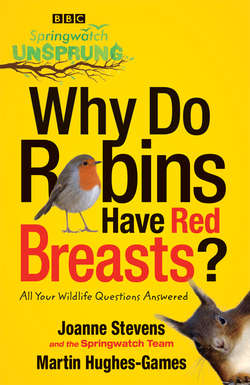Читать книгу Springwatch Unsprung: Why Do Robins Have Red Breasts? - Jo Stevens - Страница 19
Eggstatic
ОглавлениеHow can a tiny bird lay three or four eggs that have a total volume similar to that of themselves? Lin
Which bird lays the most eggs in one go? Dicky
Producing eggs requires a lot of effort and energy. In robins, for example, a complete clutch may be equivalent to 90 per cent of the female’s body weight. During the laying period, female birds need to rest and eat extra calories – they often rely on their partner to bring them food. Each egg must be provided with a fat-rich yolk to feed the growing embryo, which is surrounded by egg white (albumen) and then encased in a calcium-rich shell. Not only is finding extra food and producing the eggs energetically costly but birds also have to raise their metabolic rate to generate enough warmth to incubate them.
Most songbirds lay just one egg per day while larger species such as swans or geese may have a one- or two-day interval between eggs. Eggs are heavy, and if the female retained them inside her body they would weigh her down, so as soon as an egg has formed it is laid. In the UK, the grey partridge has the largest clutch of any bird, usually 14–15 eggs in total, but they can lay up to 20 eggs. Clutches tend to be larger in species with chicks that can feed themselves soon after hatching, such as many waterfowl, while species whose chicks need more care and attention have smaller clutches. Many seabirds are long-lived and have just one egg per season, investing a lot of time and energy into feeding and raising a single chick.
Some birds, like great tits, have a single large clutch per year to coincide with a peak in food (caterpillars in the great tit’s case), literally putting all their eggs in one basket. If the parents get the timing wrong or if their food supply fails they will have little breeding success. Other species, such as robins, spread their risk and can squeeze in two, three or even more clutches, especially if one brood fails, but have fewer eggs in each clutch.
The embryos inside fertilised eggs don’t begin to develop until they are incubated by the parent. Some species, such as barn owls, start incubation as soon as the first egg is laid so the eggs hatch asynchronously over several days. This means that the first chicks are much larger than later ones and may even eat their younger siblings if food is scarce, as we saw on Springwatch with a barn owl chick named Hannibal. Most songbirds delay incubation until the clutch is complete, in which case all the eggs hatch at roughly the same time and the chicks are all a similar size. There may still be a runt of the clutch, because the final egg sometimes has fewer resources put into it, but generally each of these chicks has a more even chance of survival.
